#Lucayan Archipelago
Explore tagged Tumblr posts
Text
Paradise Island, Bahamas: Experience the beauty of a cruise ship docked in Paradise Island, Bahamas... Paradise Island is an island in The Bahamas formerly known as Hog Island. The island, with an area of 277 hectares, is located just off the shore of the city of Nassau, which is itself located on the northern edge of the island of New Providence. It is best known for the sprawling resort Atlantis with its extensive water park rides, pools, beach, restaurants, walk-in aquarium and casinos. Wikipedia
#Paradise Island#Hog Island#Nassau#New Providence#Atlantic Ocean#Lucayan Archipelago#north carolina#north america continent
215 notes
·
View notes
Text
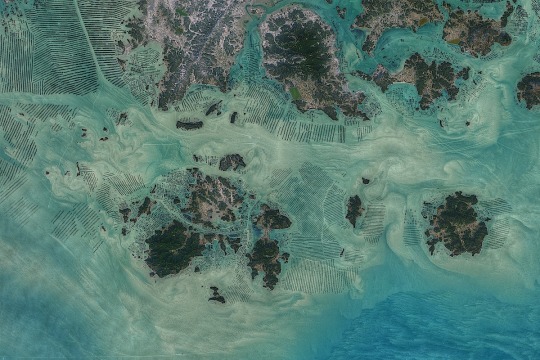
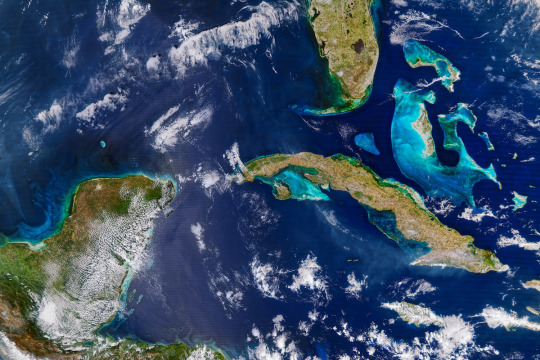
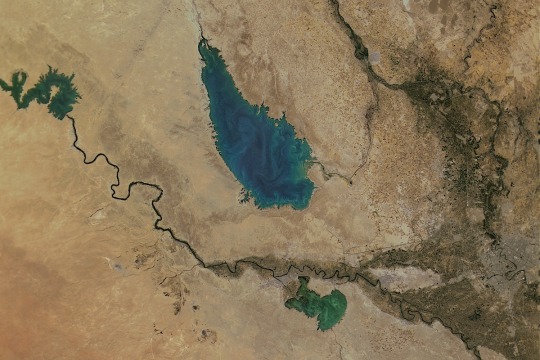
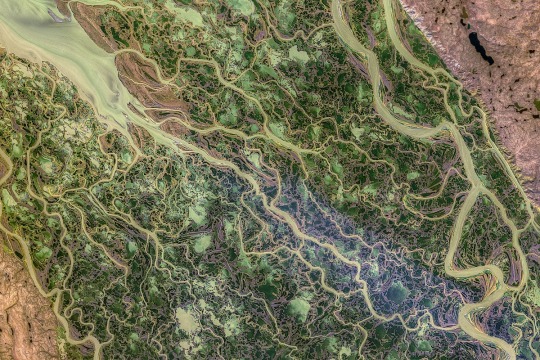

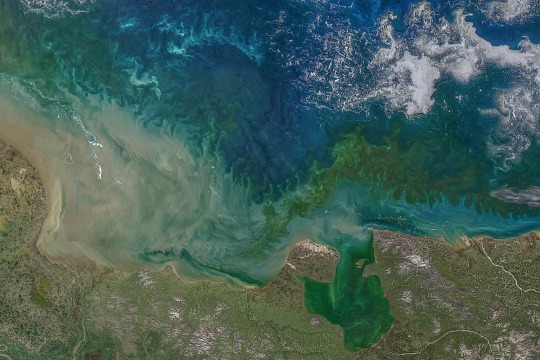

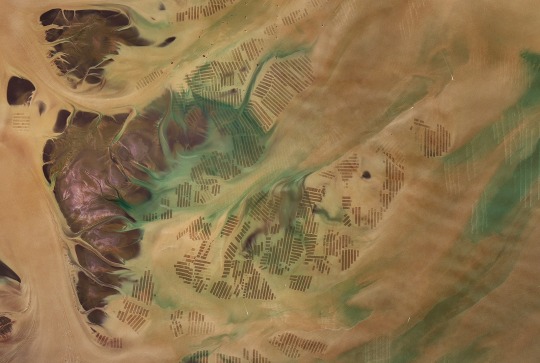
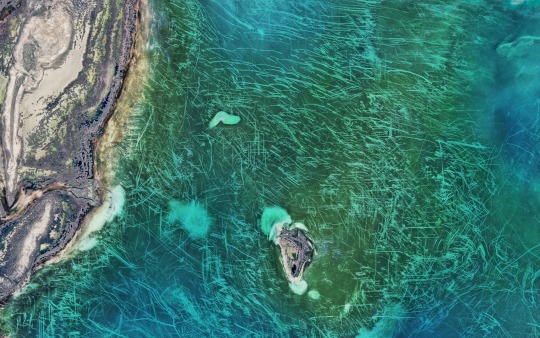
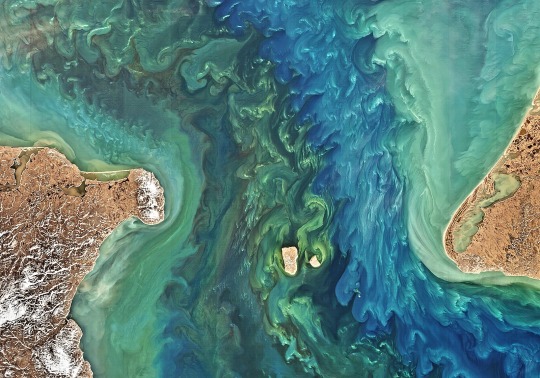
Some cool satellite imagery I collected for something at work. All images are taken from NASA's Ocean Color Web at the Ocean Biology Distributed Active Archive Center (OB.DAAC).
Info about each image under cut.
1. South Korean Aquaculture - Aquaculture operations off the southern end of the Korean Peninsula, featuring tide-drive swirls of suspended sediment and phytoplankton (captured by Landsat 8 on Feb. 19, 2021)
2. Smoke on Blue Waters - Coastal waters of the SE Gulf of Mexico, Western Caribbean Sea, and Lucayan Archipelago. Smoke plumes from forest fires in Cuba can also be seen (captured by Aqua-MODIS sensor on March 1, 2023)
3. Mesopotamia- The artificial Lake Tharthar near Baghdad and the Tigris and Euphrates Rivers (captured by SeaHawk/HawkEye on September 11, 2021)
4. Mackenzie River Delta - A heavy sediment load delivered by Canada's Mackenzie River to its delta by the Beaufort Sea (collected by Landsat 8 on September 9, 2021)
5. Svenskøya - Dense blooms of phytoplankton around the island of Svenskøya in the Svalbard Archipelago (captured by Landsat 8 on July 6, 2021)
6. East Siberian Sea - Color from phytoplankton, suspended sediments, and colored dissolved organic matter from sea ice (captured by Aqua/MODIS on July 20, 2020)
7. Laptev Sea Ice - Thin sea ice in the southern Laptev Sea transmitting colors of water, algae, sediment, colored dissolved organic matter, and the ice itself (captured by Landsat 8 on June 12, 2020)
8. Chinese Aquaculture - Aquaculture in the Yellow Sea off the coast of Jiangsu Province (captured by Landsat 8 on March 8, 2017)
9. Ice Gouges in the Caspian Sea - Lines on the floor of the Caspian Sea in the Tyuleniy Archipelago that were gouged out by ice (captured by Landsat 8/OLI on April 6, 2016)
10. The Bering Strait - The Bering Strait joining the Bering (south) and Chukchi (north) seas. It is the only connection between the Pacific and Arctic Oceans (captured by Landsat-8/OLI on June 17, 2015)
32 notes
·
View notes
Text
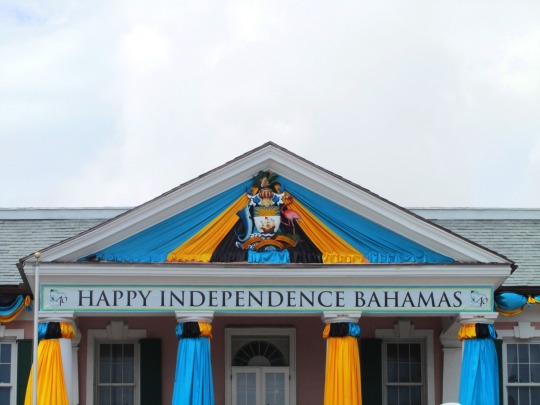
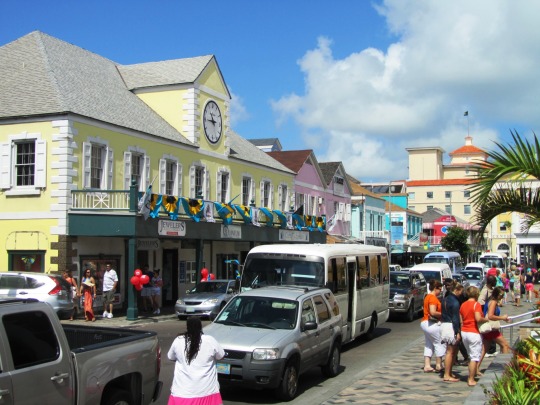
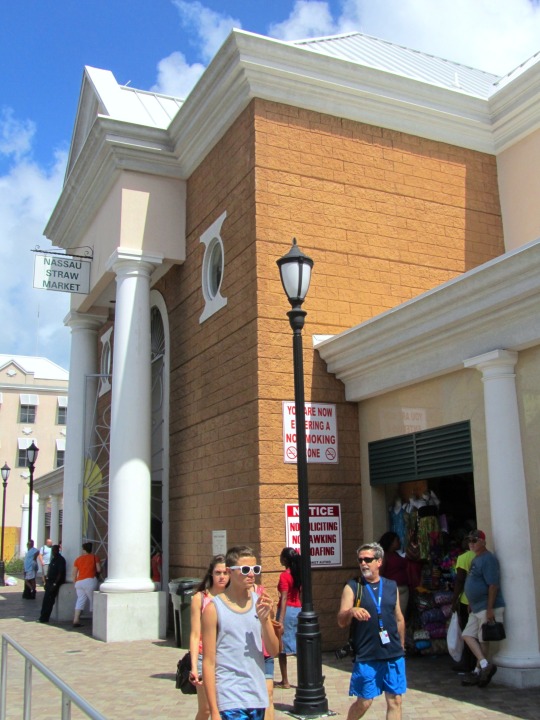
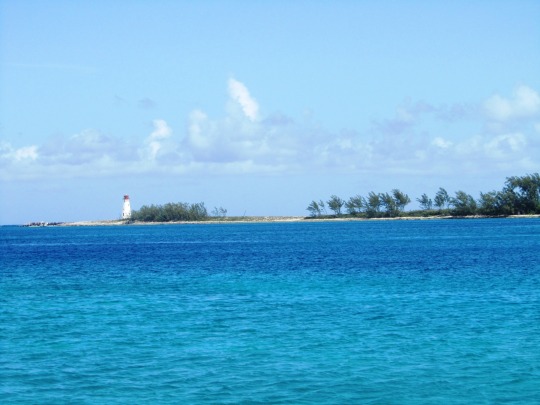
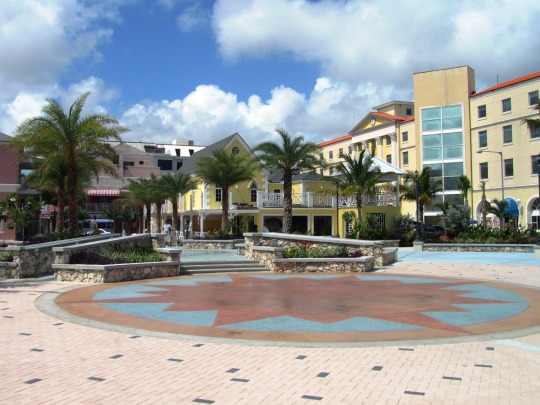
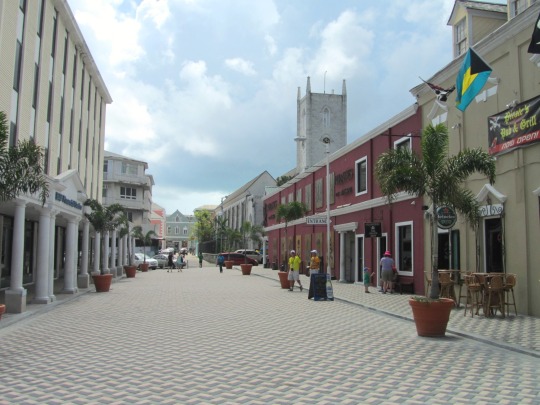

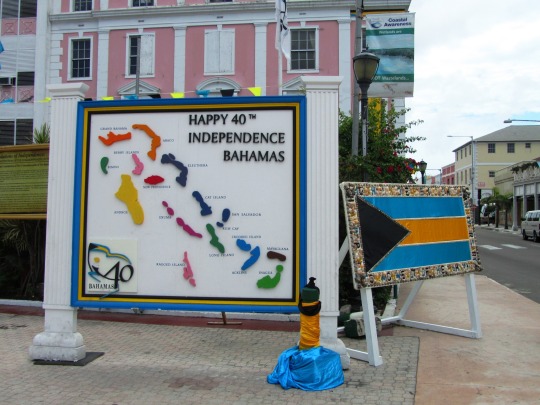
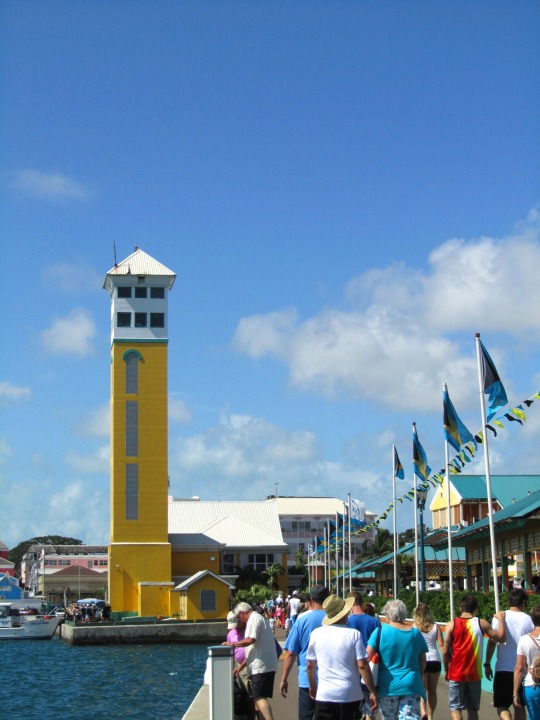
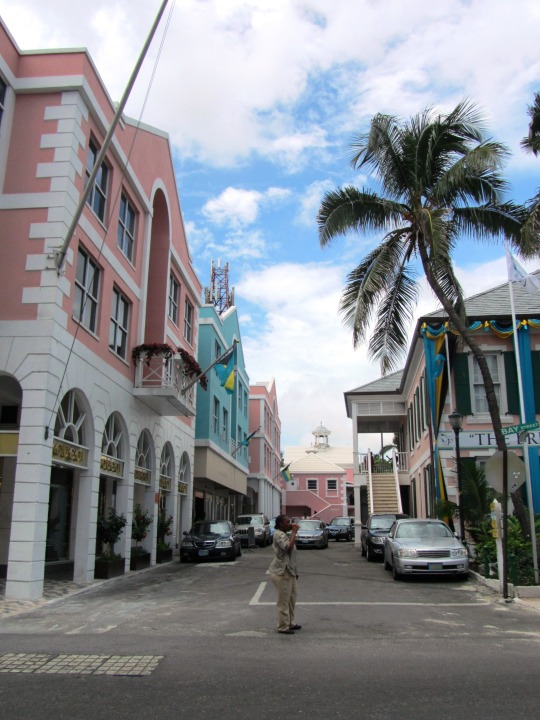
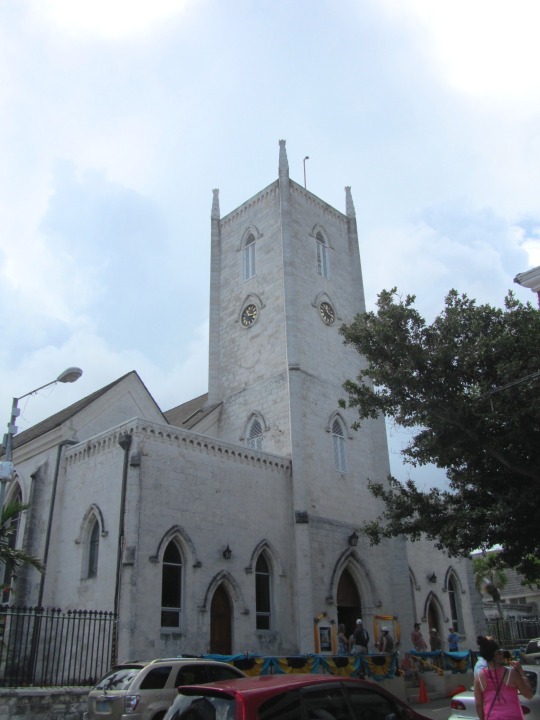

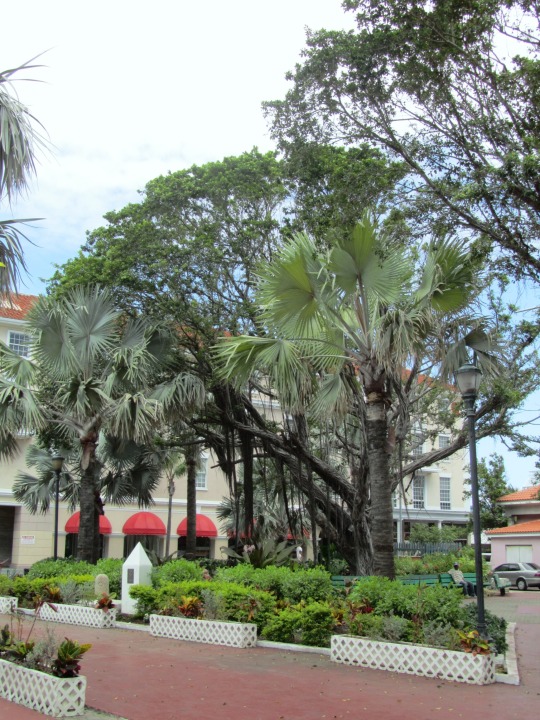
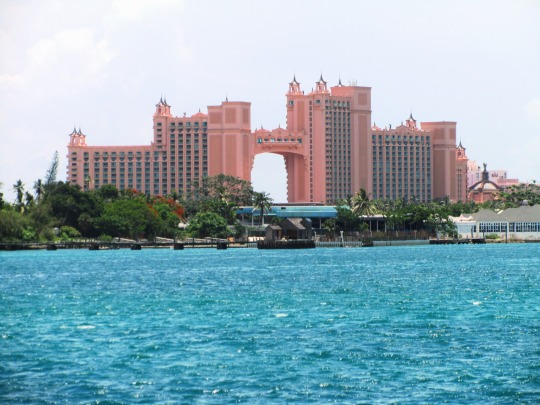
The Bahamas gained full independence within the Commonwealth of Nations on July 10, 1973.
Bahamas Independence Day
We are celebrating Bahamas Independence Day on July 10. The Bahamas is a small island nation south of Florida and north of Cuba. The island nation of the Bahamas is the ‘Commonwealth of The Bahamas.’ It is a sovereign country in the Lucayan Archipelago in the Atlantic. The country gained its independence on July 10, 1973. Prince Charles himself handed over the documentation to Prime Minister Lynden Pindling, officially making the Bahamas a fully independent nation. We celebrate the nation’s culture, traditions, and natural beauty on this day. Join us and be a part of the Bahamas Independence Day celebrations.
History of Bahamas Independence Day
The history of the Bahamas Islands starts with the Lucayans inhibiting the islands between 500 A.D. and 800 A.D. The Lucayans were a branch of the Tainos from the Caribbean islands at the time. For many centuries, they lived on their own without foreign interference until 1492. Christopher Columbus saw the islands, and Spanish ships followed him. They enslaved the native population, resulting in the island becoming deserted in 1513. English colonists started settling on the island in 1648.
The shallow water of the island made it difficult for the large ships to reach it. But it also provided easy passage to smaller ships. Pirates took advantage of this geography, and as a result, the place became a haven for pirates. Nassau on New Providence Island in the Bahamas was the stronghold of a loose confederacy of pirates between 1706 and 1718. The British took harsh measures, and the Bahamas became a colony in 1718. Further migrations happened after the American Revolutionary War. Thousands of American loyalists received land grants in the Bahamas and settled there. They also brought with them forced laborers and established plantations. Soon, the Bahamas was populated by enslaved African people. The Bahamas became a haven for the freed slaves when it abolished slavery. Today, 90% of the population are Afro-Bahamians.
The Bahamas then gained independence in 1973, led by Sir Lynden O. Pindling. Pindling’s actions earned him the name “Father of the Nation�� of the Bahamas. He was pivotal in the independence of the nation. Queen Elizabeth II became the “Queen of the Nation.” Most of the country’s economy is driven by tourism and offshore finance.
Bahamas Independence Day timeline
500 A.D. — 800 A.D.
Lucayans in the Bahamas
The Lucayans reach the Bahamas after crossing the ocean from Cuba with canoes.
1492
The First Sighting of the Bahamas
Columbus discovers the Bahamas during his journey to the New World.
1706 — 1718
Pirates in New Providence Island
New Providence island hosts the stronghold of the Republic of Pirates for about 11 years.
1807
The British Abolish the Slave Trade
The British abolish the slave trade resulting in a large number of free slaves in the Bahamas.
Bahamas Independence Day FAQs
Which country owns the Bahamas?
No country owns the Bahamas. It is an independent nation that was formerly a British territory.
What is the language used in the Bahamas?
English is primarily used.
Where did the people of the Bahamas come from?
The original inhabitants of the Bahamas were the indigenous Lucayan population. They come from Hispaniola and Cuba between 1100 A.D. to 1200 A.D.
How to Observe Bahamas Independence Day
Watch the parades
The Bahamas hosts parades and musical performances to mark the day. Try to watch the whole thing. You can see them on any online news channel.
Visit the nation
If you can directly visit the nation, then by all means do that. The Bahamas is full of pristine white sand beaches and turquoise waters. Enjoy your summer!
Create a historical timeline poster
The Bahamas has a very long and rich history. Create a poster illustrating the historical timeline of the nation. Mention how the nation turned from an unknown backwater to a rich natural paradise.
5 Facts About Bahamas That You Should Know
The ocean floor is visible
In the Bahamas, it is possible to see the ocean floor that can be 200 feet below the surface.
A nation of islands
There are 700 islands in the Bahamas and only 30 are inhabited.
The third-largest barrier reef
The Andros Barrier Reef in the Bahamas is the third-largest barrier reef.
It’s almost a flat nation
Mount Alvernia on Cat Island is the highest peak in the Bahamas and is only 207 feet.
The marching band is on the currency
The Nassau Police Marching Band is on the $1 note.
Why Bahamas Independence Day is Important
It celebrates the history
The Bahamas has a rich and vibrant history. Learn all about its journey to independence today.
It’s an appreciation of the culture
The day is the perfect opportunity to immerse yourself in the cultural practices of the country. Watch videos and read up online to learn all about the culture.
It encourages tourism
Who doesn’t want to visit the Bahamas? The more people discover about the country today, the more it will encourage them to visit.
Source
#Bahamas#10 July 1973#anniversary#travel#original photography#vacation#tourist attraction#landmark#cityscape#Atlantic Ocean#summer 2013#Straw Market#Rawson Square#Bahamian Parliament#Christ Church Cathedral#Paradise Island#architecture#Caribbean Sea#Bahamas Independence Day#Bahamian history
5 notes
·
View notes
Text
Bahamas Travel Guide
Visit :- https://www.bahamastouristtravelguide.com/savethousands Contact Us directly at 1.242.454-3003 Email us at [email protected]
The Bahamas is a beautiful tropical destination made up of over 700 islands and cays, offering everything from pristine beaches to vibrant culture. Whether you're looking to relax by the ocean, explore marine life, or immerse yourself in local history, there’s something for every kind of traveler. Here's your guide to the Bahamas:
Top Islands to Visit: Nassau (New Providence Island): The capital city, Nassau offers a mix of history, culture, and modern attractions. Explore the Pirates Museum, Fort Fincastle, and enjoy shopping at Bay Street. There’s also plenty of resorts and beaches.
Paradise Island: A short bridge ride from Nassau, home to the famous Atlantis Resort, an expansive property with a water park, aquariums, casinos, and luxury shopping.
Grand Bahama Island: Known for its eco-tourism and beautiful beaches, Grand Bahama offers the Lucayan National Park, Gold Rock Beach, and Port Lucaya Marketplace.
Exumas: A stunning archipelago with clear turquoise waters, perfect for boating, snorkeling, and seeing the famous swimming pigs at Big Major Cay.
Eleuthera and Harbour Island: Ideal for a more peaceful, laid-back vibe. Eleuthera is home to Pink Sand Beach, and Harbour Island is known for its quaint colonial architecture and beautiful beaches.
Abacos: Popular for boating, sailing, and charming small towns. Visit Hope Town for a picturesque lighthouse and friendly locals.
Things to Do: Beaches: The Bahamas is known for its white sand beaches. Some highlights include Cable Beach (Nassau), Pink Sands Beach (Harbour Island), and Gold Rock Beach (Grand Bahama).
Water Sports: Snorkeling, scuba diving, and kayaking are some of the most popular activities. Visit Dean’s Blue Hole in Long Island, one of the world’s deepest blue holes, or check out the Thunderball Grotto in the Exumas.
Swimming with Pigs: The Exumas offer the famous experience of swimming with friendly pigs, a quirky and fun attraction.
Cultural Experiences: In Nassau, visit the National Art Gallery or take a tour of John Watling’s Distillery to learn about Bahamian rum. You can also explore Ardastra Gardens for native wildlife and flamingos.
Boating: The Bahamas is made up of islands, so renting a boat is one of the best ways to explore its many hidden gems. The Exumas, Abacos, and Eleuthera all offer stunning boating opportunities.
Conclusion: The Bahamas offers a range of experiences, from luxury resorts to quiet escapes, beautiful nature to rich culture. Whether you’re after adventure or relaxation, it’s an ideal destination for any kind of traveler.
Let me know if you need more details or help with your trip!
VisitTheBahamas #BahamasVacation #BahamasTravel #ExploreTheBahamas
0 notes
Text
Discover Paradise with Island Tours in Turks and Caicos
Turks and Caicos, a breath-taking archipelago in the Caribbean, is a top destination for travellers seeking pristine beaches, turquoise waters, and vibrant marine life. One of the best ways to explore the unique beauty of these islands is through an island tour. Whether you're interested in natural wonders, historical sites, or cultural experiences, island tours in Turks and Caicos offer something for everyone. Let's dive into the top island tours that will make your visit unforgettable.
Grace Bay and Provincials Tour
Start your adventure with a tour of Provincials, the most developed island in Turks and Caicos. Grace Bay Beach, often voted one of the world's best beaches, is a highlight. The powdery white sand and crystal-clear waters are perfect for swimming, sunbathing, and snorkelling. Many tours include stops at the Coral Gardens and Smith's Reef, where you can snorkel and see colourful fish, sea turtles, and vibrant coral formations.
A Provincials tour also offers a chance to explore the island's luxury resorts, upscale shops, and fine dining restaurants. Don't miss the opportunity to visit the Conch Farm, the only one of its kind in the world, where you can learn about the life cycle of the conch and even meet a few of these fascinating creatures.
Historical Grand Turk Tour
Step back in time with a historical tour of Grand Turk, the capital island of Turks and Caicos. Grand Turk is rich in history, with colonial architecture, charming streets, and significant landmarks. The Turks and Caicos National Museum is a must-visit, offering exhibits on the island's history, from the Lucayan Indians to the salt trade era and even the space age.
The island's historic Cockburn Town is perfect for a leisurely stroll, where you can admire the quaint colonial buildings and visit the iconic Grand Turk Lighthouse. Many tours also include a visit to the Governor's Beach, a pristine spot ideal for swimming and relaxing.
North and Middle Caicos Eco-Tours
For nature enthusiasts, an eco-tour of North and Middle Caicos is a must. These islands are known for their lush landscapes, caves, and beautiful beaches. A popular stop is Mudjin Harbor on Middle Caicos, where dramatic cliffs and turquoise waters create a stunning backdrop. The Conch Bar Caves, one of the largest cave systems in the Caribbean, offers a fascinating underground adventure with guided tours that highlight the natural formations and historical significance.
In North Caicos, you can explore the island's plantations, such as the Wades Green Plantation, which offers a glimpse into the island's agricultural past. The lush vegetation and abundant birdlife make it a paradise for birdwatchers and nature lovers.
Private Island Hopping Tours
For a more exclusive experience, consider a private island hopping tour. These tours allow you to explore multiple islands and cays, each with its own unique charm. Visit the uninhabited cays like Little Water Cay, also known as Iguana Island, where you can see the endangered rock iguanas in their natural habitat.
A private tour often includes stops at secluded beaches, perfect for a picnic or a quiet swim. Some tours offer customizable itineraries, allowing you to tailor your adventure to your interests, whether it's snorkelling, fishing, or simply relaxing on a deserted beach.
Cultural and Culinary Tours
Immerse yourself in the local culture with a cultural and culinary tour of Turks and Caicos. Visit local markets, where you can sample traditional foods and purchase handmade crafts. Engage with the friendly locals and learn about the island's rich heritage and traditions.
Many tours include a visit to a local restaurant or cooking class, where you can learn to prepare traditional dishes using fresh, local ingredients. Taste the flavours of the Caribbean, from conch fritters to fresh seafood, and discover the culinary delights that make Turks and Caicos a food lover's paradise.
Plan Your Island Tour Today
island tours turks and caicos offer a perfect blend of adventure, relaxation, and cultural immersion. Whether you're exploring the historical sites of Grand Turk, the natural wonders of North and Middle Caicos, or the luxurious beaches of Provincials, these tours provide an unforgettable experience.
Book your island tour today and get ready to discover the paradise that is Turks and Caicos. From pristine beaches to vibrant culture, these islands have it all, and an island tour is the perfect way to experience it.
0 notes
Text
0 notes
Text
Discover the Bahamas: A Comprehensive Travel Guide
Welcome to the Bahamas, an archipelago of stunning islands and vibrant culture nestled in the Atlantic Ocean. This travel guide offers a thorough overview to help you plan your perfect Bahamian getaway. A Brief History The Bahamas’ history begins with the Lucayans, the first inhabitants who lived here for centuries before Christopher Columbus arrived in 1492, marking the start of European…
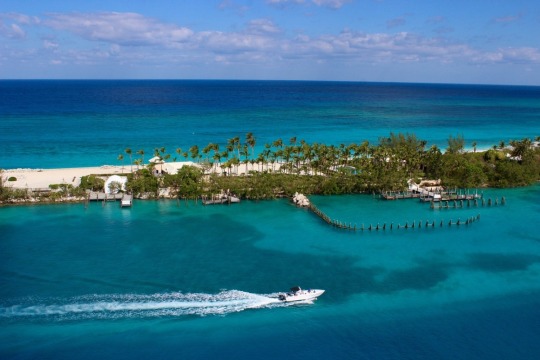
View On WordPress
#A Brief History of the bahamas#Activities for Tourists in the Bahamas#adventure#africa#Atlantic Ocean#Bahama Mama (a tropical cocktail)#bahamas#Bahamas tourists VISA#Blackbeard#Boating and Sailing#Can I use my cell phone in the Bahamas?#conch#Cost of living in the Bahamas#destinations#Discover the Bahamas: A Comprehensive Travel Guide#europe#Exuma Cays#Fishing#Food to try in the Bahamas#Free National Movement (FNM)#Grand BAhama Island#Harbour Island#Historical Tours#How do I get around the islands?#How safe is the Bahamas#Is the bahamas safe?#kenya#Lynden Pindling International Airport#Nassau#Nature Trails
0 notes
Text
The Turks and Caicos Islands, often abbreviated as TCI, are a British Overseas Territory situated in the Lucayan Archipelago of the Atlantic Ocean, southeast of the Bahamas and north of Hispaniola. Comprising of about 40 islands and cays, the territory is divided into two island groups: the larger Caicos Islands and the smaller Turks Islands. The islands are known for their stunning beaches, crystal-clear turquoise waters, and vibrant coral reefs, making them a popular destination for tourists seeking sun, sand, and sea.
The history of the Turks and Caicos Islands is rich and varied. Originally inhabited by the Taino and Lucayan peoples, the islands were later colonized by the Spanish in the 15th century. However, by the early 17th century, the islands had become a haven for pirates, including the infamous Calico Jack, who used the islands as a base for their operations.
In the late 17th century, the islands came under British control and were subsequently annexed to Jamaica. In the 18th and 19th centuries, the islands' economy relied heavily on salt production, with large salt ponds found throughout the islands. Slaves were imported to work in the salt industry, and their descendants form a significant part of the islands' population today.
Following the abolition of slavery in the British Empire in 1834, the islands experienced a period of economic decline. However, in the 20th century, tourism began to emerge as a significant industry, fueled by the islands' natural beauty and proximity to the United States.
Today, the Turks and Caicos Islands are a popular tourist destination, known for their luxurious resorts, world-class diving and snorkeling sites, and charming island culture. The official language of the islands is English, reflecting their status as a British Overseas Territory. However, due to the islands' location and history, there is also a significant influence of Creole languages, particularly in informal settings and among the local population.
Overall, the Turks and Caicos Islands are a unique blend of Caribbean charm, British heritage, and natural beauty, offering visitors an unforgettable tropical experience.
https://youtu.be/7jUyaRNgdi8?si=GEEF0HnPuZ-g6e1P
#youtube#Turks and Caicos#tourism#beautiful beaches#white sand#Caribbean Islands#where can i find Turks and Caicos
1 note
·
View note
Text
Five steps of Wikipedia for Saturday, 27th April 2024
Welcome, bienvenue, ongi etorri, fàilte 🤗 Five steps of Wikipedia from "Ricardo McPhee" to "10th parallel south". 🪜👣

Start page 👣🏁: Ricardo McPhee "Ricardo Rivaldo Jade McPhee (born 3 June 1999) is a Bahamian footballer who plays for United FC and the Bahamas national football team...."
Step 1️⃣ 👣: The Bahamas "The Bahamas ( bə-HAH-məz), officially the Commonwealth of The Bahamas, is a country in North America. It is an island country within the Lucayan Archipelago of the West Indies in the Atlantic Ocean. It contains 97% of the Lucayan Archipelago's land area and 88% of its population. The archipelagic..."
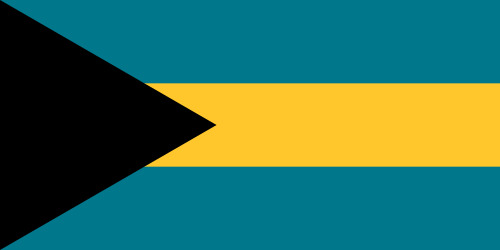
Image by Government of Bahamas
Step 2️⃣ 👣: 28th parallel north "The 28th parallel north is a circle of latitude that is 28 degrees north of the Earth's equatorial plane. It crosses Africa, Asia, the Pacific Ocean, North America and the Atlantic Ocean. In Mexico the parallel defines the border between the states of Baja California and Baja California Sur. This..."

Image licensed under CC BY-SA 3.0? by Bazonka
Step 3️⃣ 👣: 10th parallel north "The 10th parallel north is a circle of latitude that is 10 degrees north of the Earth's equatorial plane. It crosses Africa, the Indian Ocean, the Indian Subcontinent, Southeast Asia, the Pacific Ocean, Central America, South America and the Atlantic Ocean. At this latitude the sun is visible for 12..."
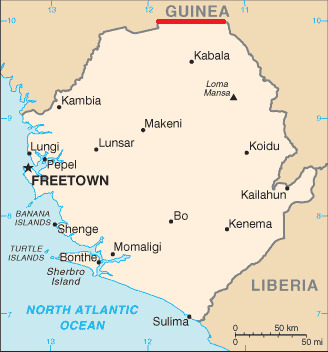
Image by Bazonka; CIA
Step 4️⃣ 👣: 105th meridian east "The meridian 105° east of Greenwich is a line of longitude that extends from the North Pole across the Arctic Ocean, Asia, the Indian Ocean, the Southern Ocean, and Antarctica to the South Pole. Under mean solar time represents the offset of UTC+07:00 time zone. The 105th meridian east forms a..."
Step 5️⃣ 👣: 10th parallel south "The 10th parallel south is a circle of latitude that is 10 degrees south of the Earth's equatorial plane. It crosses the Atlantic Ocean, Africa, the Indian Ocean, Australasia, the Pacific Ocean and South America. Part of the border between Brazil and Peru is defined by the parallel...."
0 notes
Text
Exploring the Bahamas: A Journey to Paradise
Introduction
Nestled in the crystal-clear waters of the Caribbean, you'll discover a tropical paradise that beckons travelers with its pristine beaches, vibrant culture, and endless sunshine. Welcome to the Bahamas, where every moment spent here is like stepping into a postcard-worthy dream. Whether you're seeking relaxation on powdery white sands or adventure beneath the turquoise waves, this enchanting archipelago offers something for everyone.
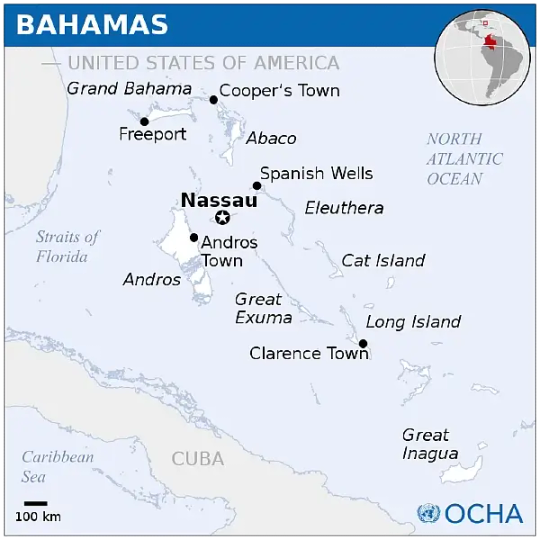
The Bahamas Location Map. Photo by UNOCHA.
Where Are the Bahamas?
A Tropical Oasis in the Western Atlantic The Bahamas are located in the western Atlantic Ocean, nestling between Florida and Cuba. Spanning an area of over 100,000 square miles, the archipelago boasts nearly 700 coral islands and cays, each with its own unique charm and appeal. While only around 30 of these islands are inhabited, the Bahamas' allure extends across the entire archipelago.
Getting to the Bahamas
A Quick and Simple Journey One of the advantages of being located so close to North America is that getting to the Bahamas is quick and simple. There are short flights from major U.S. cities like Miami or Fort Lauderdale, or you can choose to travel to the islands by ferry. Ideal for Floridians The Bahamas offers a picturesque escape just off the coast of Florida, making it an ideal vacation destination for many Floridians. Located just 50 miles east of Miami, getting to the Bahamas is relatively quick and easy. The proximity between the two places allows for various modes of travel that cater to different preferences and budgets.
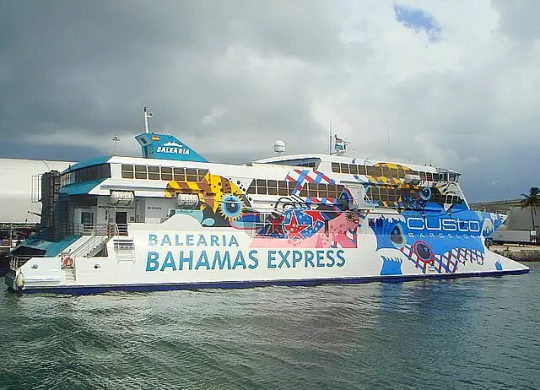
Balearia Bahamas Express. Photo by Xemenendura. Wikimedia.
How Can You Get to the Bahamas?
One popular way to reach the Bahamas from Florida is by air travel. Several airlines operate regular flights from major cities in Florida, such as Miami and Fort Lauderdale, to airports in Nassau or Freeport. These flights typically take around less than an hour, making it a convenient option for those looking to quickly immerse themselves in Bahamian culture. There are flights to the Bahamas from many capital cities worldwide. The Bahamas has 20 international airports welcoming regularly scheduled flights from around the world. There are direct flights from most European capitals. British Airways offers direct Bahamas flights from London (LHR) to Nassau four times a week. With a nine-hour flight time and a five-hour time difference between the Bahamas and the UK, it's often possible to leave in the morning and be on the beach by the afternoon. Travelers flying into Nassau have easy access to fast, connecting flights to dozens of Out Islands (also known as The Family Islands), and private charter service is readily available. For those who prefer a more leisurely journey, traveling by boat is another viable option. Numerous cruise lines offer trips from ports in southern Florida straight to the Bahamas. Depending on your departure point, these cruises can vary in length from just a few days to over a week, with voyages filled with onboard entertainment and activities. Plus, arriving by sea allows travelers ample time to soak up stunning ocean views and enjoy exciting stops along the way.
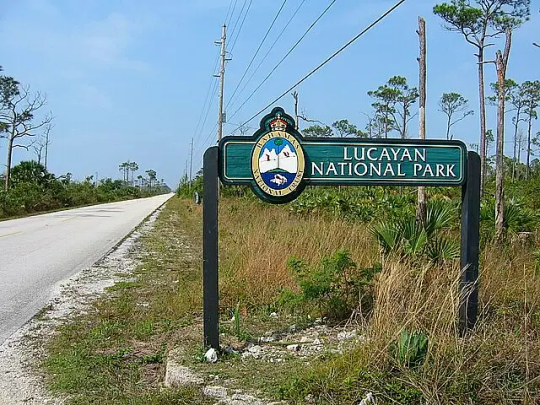
Lucayan National Park, Bahamas. Photo by Jesper Rautell Balle. Wikimedia.
History of the Bahamas
A Tapestry of Time The history of the Bahamas is rich and diverse, with its roots dating back thousands of years. The islands were first inhabited by indigenous peoples known as the Lucayans who lived there long before Christopher Columbus arrived in 1492. The Lucayan Legacy The Lucayans were a highly advanced civilization with a complex social structure and rich cultural traditions. They were skilled seafarers and navigated across vast stretches of water to trade with other nearby Caribbean islands. Their expert pottery-making, farming techniques, and impressive architectural skills are evidence of their craftsmanship and ingenuity. The European Era Tragically, after European colonization began, diseases brought by these foreign invaders decimated the Lucayan population. Many were enslaved or forced into labor by European settlers, while others fled or died due to maltreatment and disease. Some descendants of the original Lucayan people still reside in settlements on certain Bahamian islands today. In the early 17th century, Europeans established colonies in the Bahamas. Among these European colonizers were the French, who claimed parts of the islands in 1564 but abandoned their settlements a few years later due to conflicts with Spanish fleets. The Portuguese also made attempts to settle in the Bahamas, but their efforts were short-lived. It wasn't until 1629 that England established a permanent settlement on New Providence Island, making it one of Britain's oldest colonies. A Turbulent History During this time, conflict between European powers often spilled over into the Bahamas. These struggles resulted in several changes of control over the islands throughout history - British rule was interrupted by periods of Spanish ownership and even invasion from pirates. The road to independence was not an easy one for the Bahamas. After centuries under British rule, calls for political self-determination began to grow stronger in the mid-20th century. In 1964, local elections were held, and Premier Lynden Pindling became the leader of a majority black government. Four years later, negotiations with Britain led to a new constitution granting internal self-government while retaining ties with Britain as an independent Commonwealth realm. Finally, on July 10th, 1973, the Bahamas achieved full independence – marking an important milestone in their history. A Democratic Nation Since gaining independence, democracy has played a fundamental role in shaping governance in the Bahamas. The country operates as a parliamentary democracy within the Commonwealth framework. It utilizes regular elections where citizens have the opportunity to vote for their representatives.
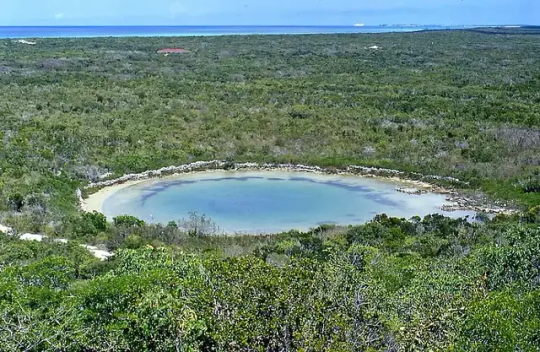
Watling's Blue Hole on San Salvador Island, Bahamas. Photo by Mark Peter. Flickr.
Geology of the Bahamas
A Geological Wonder The Bahamas comprises over 700 islands and cays, primarily consisting of limestone, a sedimentary rock that forms from the accumulation of organic materials and shells of marine organisms. The unique nature of these limestone formations stems from their origins as ancient coral reefs dating back millions of years. Blue Holes and Subterranean Secrets A hidden geological marvel lies beneath the crystal-clear waters surrounding these islands. The Bahamas sits on the boundary between two tectonic plates. The North American Plate and the Caribbean Plate. This tectonic activity has resulted in various intriguing features, including underwater sinkholes known as blue holes. These deep, circular structures are believed to have formed during glacial periods when lower sea levels allowed freshwater to dissolve portions of the porous limestone rock. The Subterranean Wonders Furthermore, exploring this diverse archipelago unveils more than just lush beaches; it reveals a treasure trove of minerals too. Although not extensively explored or exploited, Bahamian geology indicates significant mineral potential, including deposits such as aragonite, salt pans, and possible oil reserves beneath its expansive marine territory. Limestone Caves The limestone caves of the Bahamas are a geological wonder that has fascinated scientists for years. These caves, formed millions of years ago when sea levels were much lower, result in a breathtaking underground landscape with intricate formations and stunning stalactites hanging from the ceilings. One interesting feature of these limestone caves is their connection to freshwater resources on the islands. As rainwater seeps through the porous rock, it forms underground rivers and lakes within the caves. These hidden bodies of water not only provide habitats for various species of fish and other aquatic life but also serve as crucial sources of fresh drinking water for local communities. Intricate cave networks with chambers and passageways stretch for miles beneath the surface. Exploring these remarkable limestone caves offers an opportunity to witness nature's ingenuity at work while unraveling mysteries from past eons. Studying ancient fossils preserved in these caves and understanding how freshwater systems interact with cavernous landscapes offer opportunities to learn more about both our planet's history and its delicate ecological balance through an examination of these underground wonders.
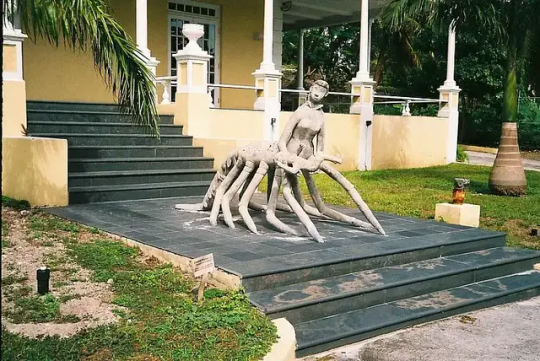
Sculpture outside the National Art Gallery of the Bahamas. Photo by Mettacitta. Flickr.
Culture of the Bahamas
A Cultural Melting Pot Despite this tumultuous past, the culture of the Bahamas is deeply rooted in its rich artistic traditions, particularly in the fields of art, sculpture, and pottery. Vibrant Art Scene The country's vibrant art scene showcases a unique blend of influences from African, European, and Indigenous cultures. These are characterized by vibrant colors and intricate designs: artists draw inspiration from their natural surroundings, creating artworks that depict the stunning landscapes and marine life that surrounds them. The World of Sculpture Sculpture also holds a prominent place in Bahamian culture, with many talented sculptors. From statues depicting historical figures to abstract sculptures inspired by nature, these creations offer glimpses into the soul of this Caribbean nation. It is fascinating to see how each sculptor brings their personal touch to their work while simultaneously paying homage to their cultural heritage. Pottery as Tradition and Art Pottery is yet another aspect of Bahamian culture that deserves recognition. The craft has been passed down through generations for centuries and remains an essential part of daily life for many locals. In addition to practical items like bowls and vases, the pottery also plays a role in preserving traditional storytelling techniques through cave drawings or symbolic motifs etched onto clay surfaces. By exploring Bahamian pottery techniques, one can gain insight into the history and evolution of this fascinating island nation. A Musical Tapestry Let's not forget the musical heritage of the Bahamas. With influences from Africa, Europe, and indigenous Bahamian traditions, the music here has evolved into a distinct sound that captivates both locals and visitors alike. The Rhythm of Junkanoo One genre that stands out is Junkanoo music. Junkanoo, a traditional Bahamian festival celebrated around Christmas time, features groups of costumed performers parading through the streets while playing rhythmic percussion instruments such as drums, cowbells, whistles, and brass instruments. The energy and exuberance of Junkanoo music are infectious, with its lively beats and syncopated rhythms creating an irresistible urge to dance. The Unique Sound of Rake and Scrape Bahamian Rake and Scrape is another unique genre that showcases the country’s musical creativity. It combines African rhythms with European accordion melodies in a distinctive fusion that sets it apart from other Caribbean genres. Originating from rural communities in the Out Islands, Rake & Scrape brings together instruments like saws (scraped with knives) for percussion, rhythm guitar, or banjo for harmony, while the accordion takes center stage as the lead instrument. The result is a soulful sound filled with passion and emotion.
Local Languages and Dialects
A Linguistic Tapestry The language of the Bahamas is a blend of African, British, and Indigenous influences, resulting in a unique and vibrant linguistic culture. The official language is English, which is widely spoken throughout the islands. However, Bahamian English has its distinct flavor with a melodic rhythm and colorful vocabulary that reflects the nation's rich history. Bahamian Creole One notable feature of Bahamian English is its strong African influence, particularly from West Africa. Bahamian English incorporates elements of Creole languages spoken by slaves brought to the Bahamas during colonial times. This linguistic fusion resulted in a unique dialect known as Bahamian Creole or Bahamianese. Although primarily spoken among older generations on some smaller islands, efforts are being made to preserve this culturally significant form of communication. Every sentence spoken in these archipelagic wonders carries echoes of centuries gone by.
Islands to Visit
A Multitude of Paradise You can stay and play on the main islands in the Bahamas, which include New Providence (often referred to as Nassau), Paradise Island, The Exumas, Bimini, Grand Bahama, Harbour Island, and Eleuthera.
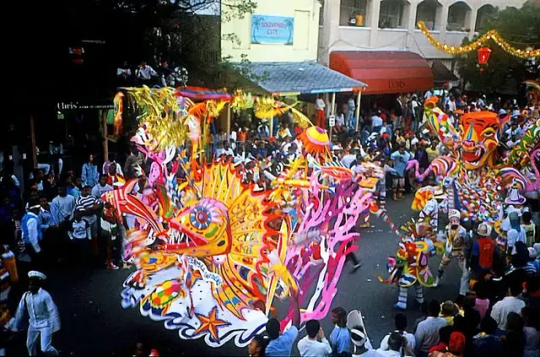
New Providence in the Bahamas The Junkanoo Festival (Vintage Photo). Photo by Rüdiger Stehn. Flickr. New Providence New Providence, the most populous island in the Bahamas, is an enticing blend of tropical paradise and vibrant city life. With its crystal-clear waters, pristine white sandy beaches, and lush vegetation, this island offers a perfect escape from the hustle and bustle of urban living. But what sets New Providence apart is its intriguing fusion of local culture with influences from around the world. As you stroll through Nassau, the capital city of the Bahamas on New Providence Island, you can't help but be captivated by its unique architecture. With colorful colonial buildings adorning street corners and picturesque pastel-colored houses lining narrow alleyways, every turn feels like a step into another time. The mix of British colonial charm with Bahamian vibrancy gives this city an enchanting atmosphere. For those seeking more than just beachside relaxation, New Providence has plenty to offer. You can experience history as you explore the ruins of Fort Fincastle or delve into the intriguing pirate legends at the Pirates of Nassau Museum. If you visit Arawak Cay Fish, you can savor local delicacies like conch fritters and tropical cocktails while immersing yourself in live music and infectious island vibes. Whether it's shopping for unique souvenirs at Straw Market or mingling with locals at the Junkanoo Festival during the Christmas season, New Providence ensures there's never a dull moment. Paradise Island Paradise Island in the Bahamas is aptly named, as it truly feels like stepping into a tropical paradise. The stunning turquoise waters and white sandy beaches are simply breathtaking, making it an ideal destination for beach lovers. However, Paradise Island offers much more than just beautiful beaches. Visitors can explore the vibrant coral reefs through snorkeling or scuba diving adventures, experiencing a colorful undersea world teeming with marine life. For those seeking some excitement and entertainment beyond the beach, Atlantis Paradise Island Resort is a must-visit destination on Paradise Island. This expansive resort complex boasts everything from luxurious accommodations to thrilling water parks and even an underwater aquarium. It's essentially a mini city where visitors can find endless entertainment options such as casinos, fine dining restaurants, shops, and live shows. With its array of activities and attractions, Paradise Island promises an unforgettable experience that goes beyond the typical beach vacation. The Exumas The Exumas, a stunning chain of over 365 cays and islands nestled in the sapphire blue waters of the Bahamas, have quietly become a haven for adventure seekers and nature lovers alike. With their crystal-clear turquoise seas teeming with vibrant marine life and pristine white-sand beaches stretching as far as the eye can see, it's no wonder that this archipelago has captured the hearts of travelers from around the globe. With its untouched beauty and beautiful beaches, it is no wonder that The Exumas have become a playground for both celebrities seeking seclusion and adventurers craving an escape from reality. One of the most unique and intriguing attractions in the Bahamas has to be the legendary swimming pigs. Nestled in the pristine waters of Exuma, these adorable pink creatures have become quite the sensation on social media. Whether you're a nature lover or an adventure seeker, interacting with these friendly and sociable pigs is an experience unlike any other. You can frolic alongside these charismatic animals in the crystal clear waters or watch them from a boat. It's no wonder that visitors from around the world flock to experience this unique event. Another main draw of The Exumas is the abundant marine life. Snorkelers and scuba divers experience an underwater extravaganza where vibrant coral reefs thrive, and majestic nurse sharks and playful dolphins accompany them. Bimini Just 50 miles off the coast of Florida, lies the island of Bimini. Often overlooked in favor of larger and more popular destinations, this small island offers a unique experience that is worth exploring. Bimini may be small in size, but it is a true paradise. Bimini has one of the most intriguing aspects, its rich history, and ties to famous figures like Ernest Hemingway. They say Hemingway found inspiration for his novel 'Islands in the Stream' during his time on this captivating island. There is even a bar named after him where you can enjoy a refreshing cocktail while gazing out at the same azure waters that inspired one of literature's greatest authors. Beyond its picturesque landscapes and historical allure, Bimini also offers incredible diving opportunities for both beginners and experienced divers alike. Read the full article
#Bahamashistoryandculture#Bahamasnaturalbeauty#Bahamastouristattractions#Bahamastravelguide#Bahamasvacationactivities#Bahamianlanguageanddialects#BestislandsintheBahamas#ExploringBahamasgeology#ExploringtheBahamas#HowtogettotheBahamas#TransportationintheBahamas
0 notes
Text
Underwater Leap, Dean's Blue Hole, Bahamas: Dean's Blue Hole is a blue hole located in The Bahamas in a bay west of Clarence Town on Long Island and is the world's third deepest with an estimated depth of 202 metres, after the Taam Ja' Blue Hole in the Chetumal Bay and the Dragon Hole in the South China Sea. Wikipedia
#Underwater Leap#Dean's Blue Hole#Clarence Town#Bahamas#Lucayan Archipelago#Atlantic Ocean#Caribbean#north america#north america continent
149 notes
·
View notes
Text


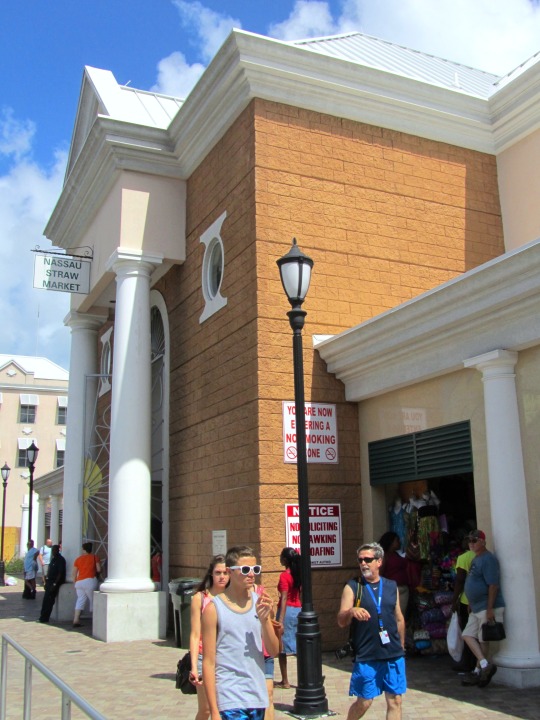
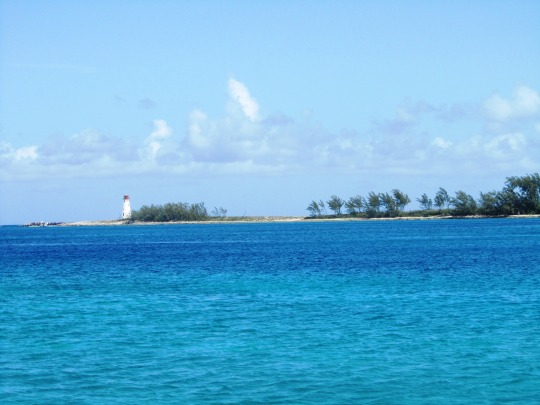
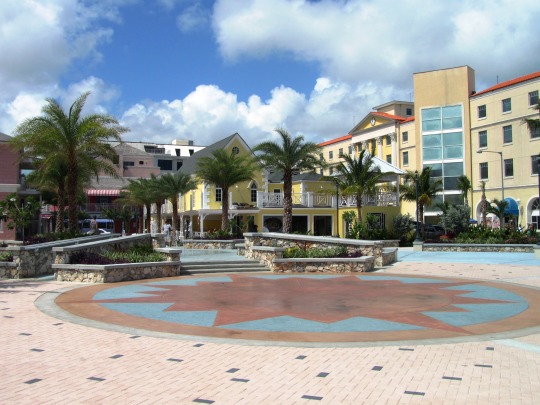
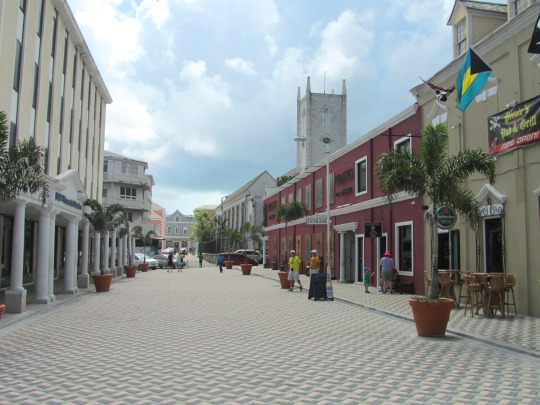
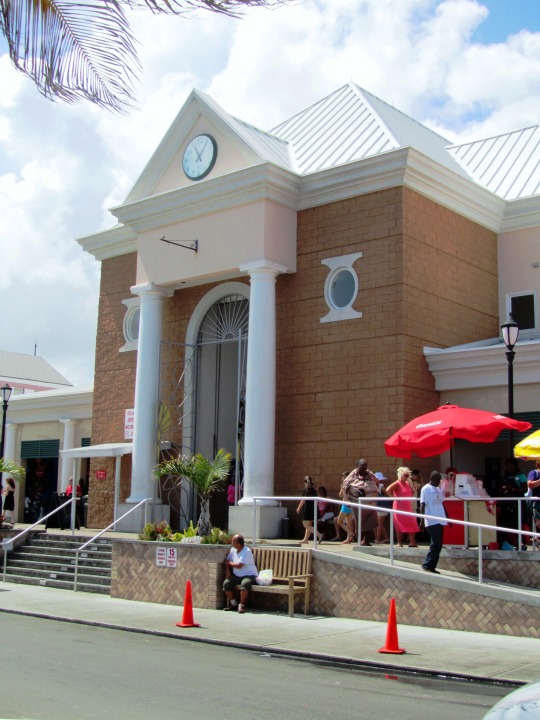
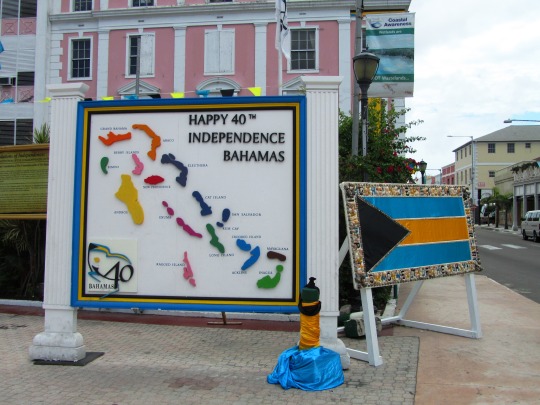

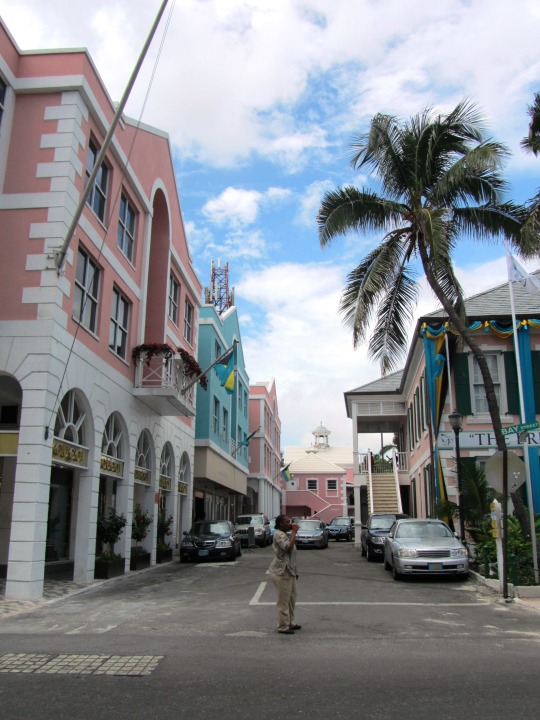
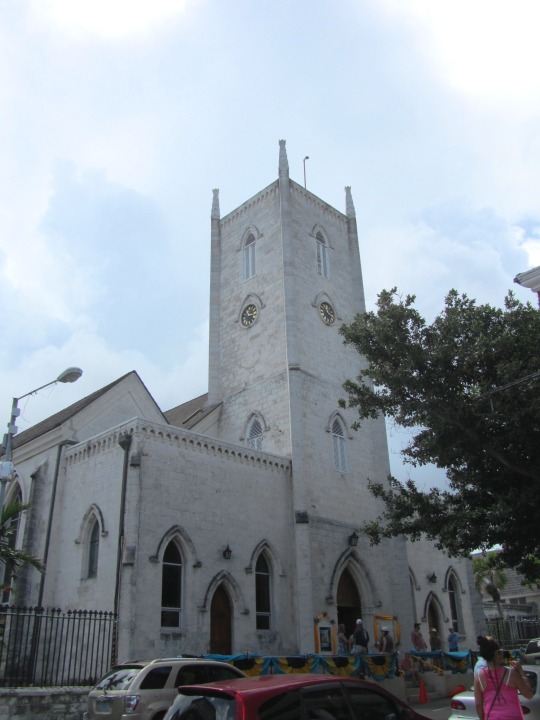
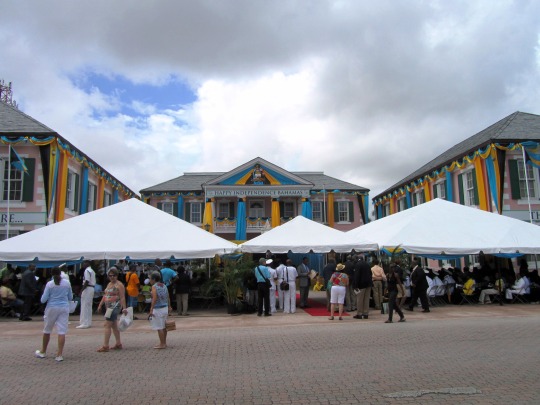
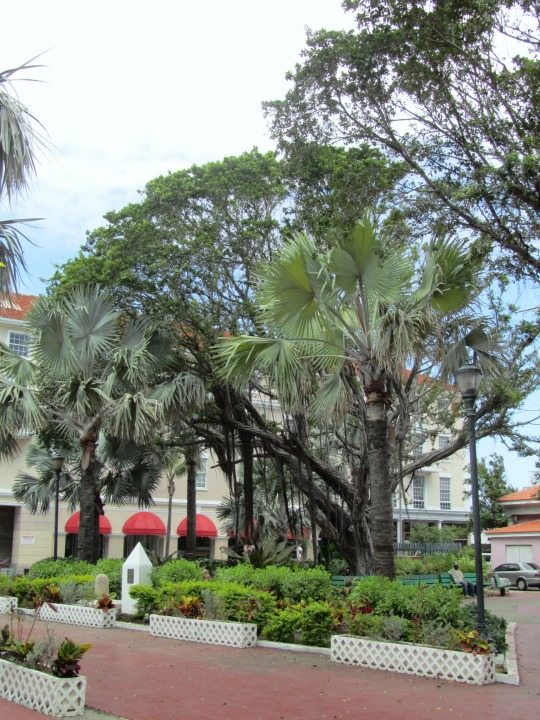
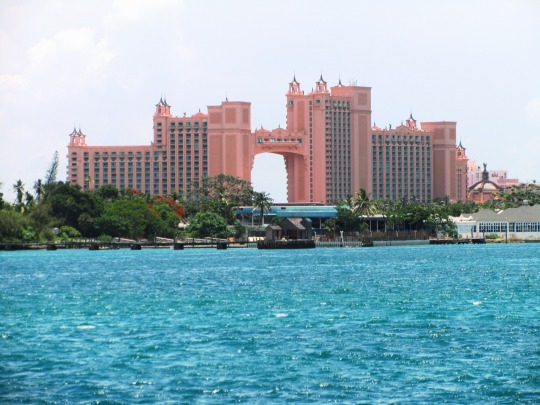
The Bahamas gained full independence within the Commonwealth of Nations on July 10, 1973.
Bahamas Independence Day
We are celebrating Bahamas Independence Day on July 10. The Bahamas is a small island nation south of Florida and north of Cuba. The island nation of the Bahamas is the ‘Commonwealth of The Bahamas.’ It is a sovereign country in the Lucayan Archipelago in the Atlantic. The country gained its independence on July 10, 1973. Prince Charles himself handed over the documentation to Prime Minister Lynden Pindling, officially making the Bahamas a fully independent nation. We celebrate the nation’s culture, traditions, and natural beauty on this day. Join us and be a part of the Bahamas Independence Day celebrations.
History of Bahamas Independence Day
The history of the Bahamas Islands starts with the Lucayans inhibiting the islands between 500 A.D. and 800 A.D. The Lucayans were a branch of the Tainos from the Caribbean islands at the time. For many centuries, they lived on their own without foreign interference until 1492. Christopher Columbus saw the islands, and Spanish ships followed him. They enslaved the native population, resulting in the island becoming deserted in 1513. English colonists started settling on the island in 1648.
The shallow water of the island made it difficult for the large ships to reach it. But it also provided easy passage to smaller ships. Pirates took advantage of this geography, and as a result, the place became a haven for pirates. Nassau on New Providence Island in the Bahamas was the stronghold of a loose confederacy of pirates between 1706 and 1718. The British took harsh measures, and the Bahamas became a colony in 1718. Further migrations happened after the American Revolutionary War. Thousands of American loyalists received land grants in the Bahamas and settled there. They also brought with them forced laborers and established plantations. Soon, the Bahamas was populated by enslaved African people. The Bahamas became a haven for the freed slaves when it abolished slavery. Today, 90% of the population are Afro-Bahamians.
The Bahamas then gained independence in 1973, led by Sir Lynden O. Pindling. Pindling’s actions earned him the name “Father of the Nation” of the Bahamas. He was pivotal in the independence of the nation. Queen Elizabeth II became the “Queen of the Nation.” Most of the country’s economy is driven by tourism and offshore finance.
Bahamas Independence Day timeline
500 A.D. — 800 A.D.
Lucayans in the Bahamas
The Lucayans reach the Bahamas after crossing the ocean from Cuba with canoes.
1492
The First Sighting of the Bahamas
Columbus discovers the Bahamas during his journey to the New World.
1706 — 1718
Pirates in New Providence Island
New Providence island hosts the stronghold of the Republic of Pirates for about 11 years.
1807
The British Abolish the Slave Trade
The British abolish the slave trade resulting in a large number of free slaves in the Bahamas.
Bahamas Independence Day FAQs
Which country owns the Bahamas?
No country owns the Bahamas. It is an independent nation that was formerly a British territory.
What is the language used in the Bahamas?
English is primarily used.
Where did the people of the Bahamas come from?
The original inhabitants of the Bahamas were the indigenous Lucayan population. They come from Hispaniola and Cuba between 1100 A.D. to 1200 A.D.
How to Observe Bahamas Independence Day
Watch the parades
The Bahamas hosts parades and musical performances to mark the day. Try to watch the whole thing. You can see them on any online news channel.
Visit the nation
If you can directly visit the nation, then by all means do that. The Bahamas is full of pristine white sand beaches and turquoise waters. Enjoy your summer!
Create a historical timeline poster
The Bahamas has a very long and rich history. Create a poster illustrating the historical timeline of the nation. Mention how the nation turned from an unknown backwater to a rich natural paradise.
5 Facts About Bahamas That You Should Know
The ocean floor is visible
In the Bahamas, it is possible to see the ocean floor that can be 200 feet below the surface.
A nation of islands
There are 700 islands in the Bahamas and only 30 are inhabited.
The third-largest barrier reef
The Andros Barrier Reef in the Bahamas is the third-largest barrier reef.
It’s almost a flat nation
Mount Alvernia on Cat Island is the highest peak in the Bahamas and is only 207 feet.
The marching band is on the currency
The Nassau Police Marching Band is on the $1 note.
Why Bahamas Independence Day is Important
It celebrates the history
The Bahamas has a rich and vibrant history. Learn all about its journey to independence today.
It’s an appreciation of the culture
The day is the perfect opportunity to immerse yourself in the cultural practices of the country. Watch videos and read up online to learn all about the culture.
It encourages tourism
Who doesn’t want to visit the Bahamas? The more people discover about the country today, the more it will encourage them to visit.
Source
#Bahamas#10 July 1973#50th anniversary#travel#original photography#vacation#tourist attraction#landmark#cityscape#Atlantic Ocean#summer 2013#Straw Market#Rawson Square#Bahamian Parliament#Christ Church Cathedral#Paradise Island#architecture#Caribbean Sea#Bahamas Independence Day
8 notes
·
View notes
Text
Turks and Caicos Islands
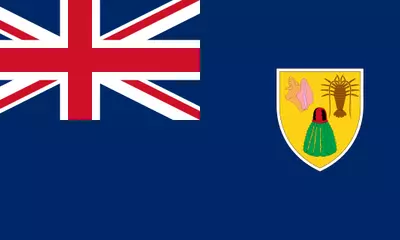
The Turks and Caicos Islands are a breathtakingly beautiful archipelago located in the Caribbean Sea. This cluster of islands is known for its crystal-clear waters, white sandy beaches, and vibrant coral reefs. However, the natural beauty of the island chain is just one aspect of its rich heritage. The Turks and Caicos Islands have a unique cultural identity shaped by the history, geography, and demography of the region. Whether you are interested in the geological makeup of the islands, the diverse ecosystems and abundant biodiversity, or the political and economic system, there is something for everyone to discover on these islands. In this article, we will explore the Turks and Caicos Islands in detail and uncover the natural and cultural treasures that make this island chain so special. From the origin of the name Turks and Caicos to the famous people who hail from these islands, we will cover everything you need to know to appreciate the richness of this unique destination. The name Turks and Caicos is thought to be derived from the indigenous Lucayan language. The Lucayan people, who were the original inhabitants of the islands, called them 'Lukku Caicos,' which roughly translates to 'string of islands.' The name was later modified by European explorers who named the islands 'Turks Islands' and 'Caicos Islands' after the two dominant indigenous tribes they encountered: the 'Turks,' who were found on the Turks Islands, and the 'Caicos,' who called the neighboring Caicos Islands home. The history of the Turks and Caicos Islands is a rich tapestry that is woven from the stories of many different peoples who have called these islands home at various times. The islands have been inhabited by the Lucayans, the Spanish, the French, the British, and African slaves brought over by the British to work on salt ponds. In 1962, the Turks and Caicos Islands became a British Overseas Territory, which granted them greater autonomy and independence in governance. Today, the islands remain a popular tourist destination and maintain a unique cultural identity that blends the influences of the many peoples who have shaped its rich history. The Turks and Caicos Islands are located on the southeastern tip of the Bahamas archipelago and consist of two island groups that run in a southeast-northwest orientation. The islands are primarily composed of low-lying carbonate rock that has been formed over millions of years from the accumulation of the skeletal remains of marine organisms. Because of this geological makeup, the islands have unique features such as the Caicos Banks, which are shallow areas of water with sand ridges that are exposed during low tide. These banks are home to a diverse array of marine life, including sea turtles, sharks, and a variety of fish species. The Turks and Caicos Islands are located in the northern Caribbean and consist of two island groups: the Turks Islands and the Caicos Islands. The islands are known for their spectacular beaches, coral reefs, and clear turquoise waters. Providenciales, the largest Caicos Island, is home to Grace Bay Beach, which has been ranked as one of the world's best beaches for its pristine white sand and crystal-clear waters. The islands are also home to several national parks, including the Princess Alexandra National Park, which protects a range of marine and terrestrial habitats, including seagrass beds and nesting sites for green turtles and hawksbill turtles. The Turks and Caicos Islands are home to an incredibly diverse range of ecosystems, including sandy beaches, mangrove forests, wetlands, and coral reefs. These ecosystems provide habitats for a variety of unique plant and animal species, some of which are found nowhere else on the planet. The islands' ecosystem is particularly important because it acts as a nursery for many marine species and helps to sustain the livelihoods of local fishermen and seafood restaurants. The islands are also home to several conservation organizations that work to preserve the natural resources and promote sustainable tourism practices. The Turks and Caicos Islands are home to an exceptional biodiversity, with over 20 endemic species found on the islands. These species include the Caicos pine, the Caicos rock iguana, and the Turks and Caicos crayfish. In addition to these endemic species, the islands are also home to a diverse range of marine life, including sea turtles, sharks, dolphins, and a variety of reef fish. The clear waters surrounding the islands make it an ideal destination for snorkeling and diving enthusiasts who want to explore the rich underwater world. The Turks and Caicos Islands have a tropical climate, with mild temperatures throughout the year. The islands experience a dry season from November to May, and a rainy season from June to October. The average temperature ranges from 75°F (24°C) in January to 85°F (29°C) in July and August. The islands are at risk of hurricanes and tropical storms, which can occur between June and November. Visitors are advised to keep an eye on weather reports during hurricane season and take necessary precautions. Despite the natural beauty of the islands, the Turks and Caicos Islands face several environmental challenges. These challenges include issues such as coral bleaching, overfishing, and coastal erosion. The islands also face the threat of rising sea levels due to climate change. Despite these challenges, there are ongoing efforts to protect the natural resources of the island chain. Several conservation organizations, such as the Turks and Caicos Reef Fund, work to promote sustainable tourism practices and protect the marine ecosystems. The Turks and Caicos Islands are a British Overseas Territory, which means that they have a governor who represents the British monarch, a locally elected government, and a legislature. The legal system is based on English common law, and there is a Supreme Court with a Chief Justice at its head. The islands maintain diplomatic relations with other countries and are members of several international organizations, including the Caribbean Community (CARICOM) and the United Nations (UN). The economy of the Turks and Caicos Islands is heavily reliant on tourism, with over one million visitors coming to the islands each year. Other important industries include fishing, salt mining, and offshore financial services. The islands have a significant number of luxury resorts that cater to high-end tourists, and the government has implemented a number of measures to encourage sustainable tourism practices. In recent years, the government has also sought to diversify the economy by promoting small and medium-sized businesses and encouraging foreign investment. The Turks and Caicos Islands have a relatively well-developed infrastructure, with paved roads, a modern telecommunications system, and several airports. There are regular flights to and from the United States, Canada, and the Caribbean. The islands also have several marinas and ports that can accommodate large cruise ships and private yachts. The Turks and Caicos Islands are home to several scientific research projects and technological innovations. These include studies of the islands' marine ecosystems and coral reefs, as well as efforts to develop renewable energy sources and environmentally-friendly tourism practices. In addition, the islands have a growing technology industry that is focused on creating software platforms and mobile apps that cater to the needs of tourists visiting the islands. The Turks and Caicos Islands have been home to several notable individuals who have made contributions to culture, sports, and politics. These include former Olympic athlete Delano Williams, writer Jeffrey Archer, and musician Prince. In addition, the islands have been a popular filming location for movies and television shows, such as the popular crime drama 'Breaking Bad.' The Turks and Caicos Islands have a diverse demographic makeup, with a population of about 50,000. The majority of the population is of African descent, with smaller populations of European, Indian, and Haitian ancestry. The islands are also home to a significant number of expatriates from the United States, Canada, and the United Kingdom. The African population of the Turks and Caicos Islands is descended from slaves brought over by the British during the 18th and 19th centuries. The European population is largely descended from British loyalists who fled the United States after the American Revolution. The Indian population of the islands initially came as indentured servants in the 1800s, while the Haitian population arrived in the 1980s and 1990s seeking political asylum. The dominant religion on the Turks and Caicos Islands is Christianity, with Protestantism being the most widely practiced. There are also small populations of Roman Catholics and Seventh-day Adventists. In addition, there is a small Muslim population and several other religious groups represented on the islands. English is the official language of the Turks and Caicos Islands and is spoken by the majority of the population. However, there are also Creole speakers, particularly among the Haitian population. The healthcare system on the Turks and Caicos Islands is relatively well-developed and includes several hospitals and clinics. There are also several private medical facilities that cater to tourists. Public health concerns include the risk of contracting mosquito-borne illnesses, such as Zika and dengue fever, as well as issues related to water and food safety. The culture of the Turks and Caicos Islands is a vibrant mix of African, European, and Caribbean influences. The islands have a rich musical heritage that includes genres such as reggae, calypso, and Junkanoo. Local cuisine is a fusion of Caribbean and African influences, with seafood being a staple. The islands also host several cultural events throughout the year, such as the annual Turks and Caicos Music and Cultural Festival, which features live music, dance, and food. The Turks and Caicos Islands offer a range of recreational activities for tourists, from diving and snorkeling to fishing and kayaking. Visitors can explore the islands on hiking and biking trails, or relax on some of the world's most beautiful beaches. The islands are also home to several luxury spas and resorts that offer a range of wellness and fitness programs to help visitors relax and rejuvenate. The Turks and Caicos Islands have several major cities, with Providenciales being the largest. Other important cities include Grand Turk, North Caicos, and South Caicos. These cities offer a mix of modern amenities and historic sites, such as museums, galleries, and colonial-era buildings. Grace Bay Beach, located in Providenciales, is one of the most beautiful cities in the world, offering some of the most stunning views of the ocean and the lush landscape. In addition, Cockburn Town, located on the island of Grand Turk, is a UNESCO World Heritage site and is home to some of the islands' most important historical sites. The Turks and Caicos Islands have a range of must-visit attractions, including Grace Bay Beach, which has been ranked as one of the world's best beaches. Chalk Sound National Park is another popular destination, featuring a stunning landscape of turquoise waters and limestone islands. The islands are also home to several cultural attractions, including the Turks and Caicos National Museum, which tells the story of the islands' rich history. The cuisine of the Turks and Caicos Islands is a festival of flavors and textures, blending Caribbean and African influences to create unique dishes. Seafood is a staple of the local cuisine and includes conch, lobster, and fish. Other popular dishes include jerk chicken, peas and rice, and Johnny Cake. The islands also have a range of signature drinks, such as the Goombay Smash, a potent blend of rum and fruit juices, and the Dark and Stormy, a cocktail made with ginger beer and dark rum. Visitors can travel to the Turks and Caicos Islands via several major airlines, including American Airlines, Delta, and United. Flights depart from major cities in North America and the Caribbean, with several routes stopping at Providenciales International Airport. The Turks and Caicos Islands offer a range of accommodation options, from luxury resorts to budget-friendly guesthouses and B&Bs. Many of the resorts are located on the islands' best beaches, offering stunning views of the ocean and world-class amenities such as spas, restaurants, and pools. Camping and RV parks are also available for those who prefer to explore the islands in a more budget-friendly way. The Turks and Caicos Islands have captured the imagination of people all over the world. Its stunning beauty, rich history, and vibrant culture have been the subject of books, films, and documentaries. The islands continue to inspire people with their unique blend of natural
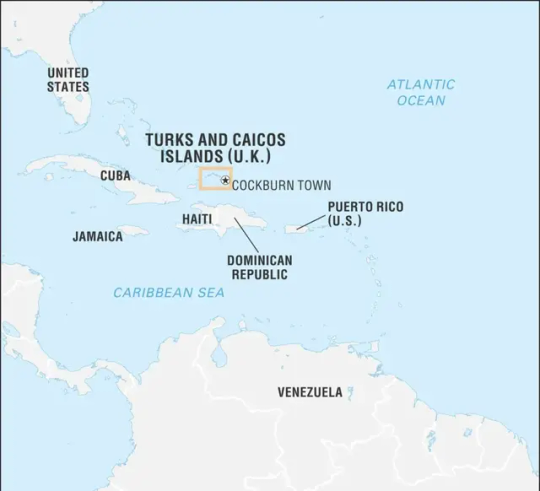
Etymology
The name "Turks and Caicos Islands" has an intriguing history that traces back to the early days of European exploration in the Caribbean. The word "Turks" is believed to have originated from the presence of Turk's Head cactus on the islands, which served as a navigation landmark for sailors. As for the "Caicos" part of the name, it is likely derived from the Taíno word "kay", which means "string of islands". This is fitting, as the Turks and Caicos Islands are comprised of a chain of 40 islands and cays. The islands were first documented by Europeans in 1512, when Spanish explorer Juan Ponce de León came across them during his search for the Fountain of Youth. However, it wasn't until the 17th century that the islands began to be settled by the British. Throughout history, the name of the island chain has undergone various changes. For a time, it was simply referred to as the "Bahama Islands", before being called the "Turks Islands". In the 19th century, the name was officially changed to the "Turks and Caicos Islands", which has remained in use ever since. Turks and Caicos Islands The Turks and Caicos Islands are a group of islands located in the Caribbean Sea. The archipelago, which is a British Overseas Territory, is made up of two main groups of islands: the Turks Islands and the Caicos Islands. There are a total of 40 islands and cays, but only eight of them are inhabited. The islands are known for their beautiful beaches and crystal-clear waters, making them a popular tourist destination. . The Turks and Caicos Islands, also known as TCI, is an archipelago consisting of 40 islands and cays located in the Atlantic Ocean, southeast of the Bahamas. The name "Turks" is believed to originate from the indigenous Turk's Head cactus, which is prevalent throughout the islands. The meaning of the Caicos, on the other hand, is less certain, with some suggesting it is derived from the Taíno word "cayo hico," meaning string of islands, while others argue it comes from the Lucayan word "caya hico," which translates to "island of the land iguana." The islands also have several nicknames, including the "Beautiful by Nature," due to their stunning natural scenery, and the "Provo," which is short for Providenciales, the most populated island in the TCI.
History
The history of Turks and Caicos is a fascinating journey that takes us back to the time of the Lucayan people, who were the island's original inhabitants. The island chain was initially named "Las Tortugas," meaning "the turtles" due to the high number of turtles found in the region. Later, the name evolved to Turks Islands after the Turk's Head cactus that grows on the islands. The first people to arrive on the islands were the Taino people, who migrated from South America, followed by the Lucayan people, who settled on the islands around 700 AD. The Lucayan people were skilled farmers and fishers and were able to survive on the islands' limited resources for over a thousand years. When Christopher Columbus arrived on the islands in 1492, the Lucayan population had dwindled significantly, primarily due to introduced diseases. The Spaniards then used the island as a stopover point and as a source of salt, which they used to preserve meat. The islands then became a haven for pirates and privateers who used them as a base to attack Spanish ships and settlements in the Caribbean. In 1710, the British crown claimed the islands, and they have remained a British Overseas Territory ever since. In the 18th and 19th centuries, the Turks and Caicos Islands played an important role in the salt industry, salt being a valuable commodity at the time used for preserving food. Slaves were brought to the islands to work in the salt industry, and this part of the island's history is still visible today in the cultural heritage of the region. In modern times, the islands have become a popular tourist destination, attracting visitors from all over the world. The tourism industry has helped boost the islands' economy, and the government has made considerable investments in infrastructure to support the industry. However, the islands have not been without their struggles. In 2009, the entire government was disbanded due to corruption, with the British government taking direct control of the islands for a brief period. The history of the Turks and Caicos Islands is rich and complex, with a mix of cultures and influences shaping the islands into what they are today. From the indigenous peoples to the pirates and privateers, from the salt industry to the modern tourism industry, the islands have a unique and fascinating story to tell. Geology The Turks and Caicos Islands are a unique set of islands with fascinating geological features that contribute to their beauty. The islands are a part of the Lucayan Archipelago and are situated on the southeastern edge of the Bahamian and the northern edge of the Caribbean tectonic plate. The islands are made up of two main groups: the Turks Islands which consist of Grand Turk and Salt Cay, and the Caicos Islands which include Providenciales, Middle Caicos, and North Caicos. The geology of the islands is diverse, ranging from sedimentary rocks to limestone formations that have been shaped by marine erosion, weathering, and tectonic activity. Limestone is the most common rock type on the islands, and it is formed from ancient coral and shell deposits that were compressed over time. As a result, the islands are rich in marine fossils and karst topography, including caves, sinkholes, and cliffs. Due to the unique geological makeup of the islands, there are several natural attractions worth a visit. For example, the Chalk Sound National Park located on Providenciales Island is home to a picturesque lagoon with crystal-clear turquoise water and limestone islets. Guests can explore the area by kayak or stand-up paddleboard to get a closer look at the unique geology of the region. The islands also boast several underground caves that are formed from limestone, such as the Conch Bar Caves on Middle Caicos Island. These caves are believed to have formed thousands of years ago and served as a shelter for the Taino people. Visitors can explore the caves to learn about the geology and history of the islands. Read the full article
#CaribbeanTours#TravelTheWorld#TurksandCaicosIslandstours#TurksandCaicosIslandsTravel#visitTurksandCaicosIslands
0 notes
Text

Bahamas Travel Guide
Visit :- https://www.bahamastouristtravelguide.com/savethousands Contact Us directly at 1.242.454-3003 Email us at [email protected]
The Bahamas is a beautiful tropical destination made up of over 700 islands and cays, offering everything from pristine beaches to vibrant culture. Whether you're looking to relax by the ocean, explore marine life, or immerse yourself in local history, there’s something for every kind of traveler. Here's your guide to the Bahamas:
Top Islands to Visit: Nassau (New Providence Island): The capital city, Nassau offers a mix of history, culture, and modern attractions. Explore the Pirates Museum, Fort Fincastle, and enjoy shopping at Bay Street. There’s also plenty of resorts and beaches.
Paradise Island: A short bridge ride from Nassau, home to the famous Atlantis Resort, an expansive property with a water park, aquariums, casinos, and luxury shopping.
Grand Bahama Island: Known for its eco-tourism and beautiful beaches, Grand Bahama offers the Lucayan National Park, Gold Rock Beach, and Port Lucaya Marketplace.
Exumas: A stunning archipelago with clear turquoise waters, perfect for boating, snorkeling, and seeing the famous swimming pigs at Big Major Cay.
Eleuthera and Harbour Island: Ideal for a more peaceful, laid-back vibe. Eleuthera is home to Pink Sand Beach, and Harbour Island is known for its quaint colonial architecture and beautiful beaches.
Abacos: Popular for boating, sailing, and charming small towns. Visit Hope Town for a picturesque lighthouse and friendly locals.
Things to Do: Beaches: The Bahamas is known for its white sand beaches. Some highlights include Cable Beach (Nassau), Pink Sands Beach (Harbour Island), and Gold Rock Beach (Grand Bahama).
Water Sports: Snorkeling, scuba diving, and kayaking are some of the most popular activities. Visit Dean’s Blue Hole in Long Island, one of the world’s deepest blue holes, or check out the Thunderball Grotto in the Exumas.
Swimming with Pigs: The Exumas offer the famous experience of swimming with friendly pigs, a quirky and fun attraction.
Cultural Experiences: In Nassau, visit the National Art Gallery or take a tour of John Watling’s Distillery to learn about Bahamian rum. You can also explore Ardastra Gardens for native wildlife and flamingos.
Boating: The Bahamas is made up of islands, so renting a boat is one of the best ways to explore its many hidden gems. The Exumas, Abacos, and Eleuthera all offer stunning boating opportunities.
Conclusion: The Bahamas offers a range of experiences, from luxury resorts to quiet escapes, beautiful nature to rich culture. Whether you’re after adventure or relaxation, it’s an ideal destination for any kind of traveler.
Let me know if you need more details or help with your trip!
VisitTheBahamas #BahamasVacation #BahamasTravel #ExploreTheBahamas #BahamasIslands #DiscoverBahamas #TropicalParadise #BahamasBeaches #Exumas #NassauBahamas #ParadiseIsland #SwimWithPigs
0 notes
Text
Discover Unforgettable Adventures with Excursions in Turks and Caicos
Turks and Caicos, a stunning archipelago in the Caribbean, is a dream destination for travelers seeking both relaxation and adventure. Known for its pristine beaches, crystal-clear waters, and vibrant marine life, the islands offer a plethora of exciting excursions that cater to all interests. Whether you're a nature lover, a history buff, or a thrill-seeker, there's an excursion in Turks and Caicos that's perfect for you.
Snorkeling and Scuba Diving Excursions
Turks and Caicos are home to some of the best snorkeling and scuba diving sites in the world. The islands boast an extensive coral reef system, which is teeming with colorful fish, sea turtles, and other marine life. Grace Bay, Smith's Reef, and Bight Reef are popular spots for snorkeling, where you can easily access the vibrant underwater world.
For a more immersive experience, join a scuba diving excursion. Explore the dramatic underwater walls at West Caicos or French Cay, where the reef drops off into the deep blue abyss. Encounter majestic stingrays, playful dolphins, and even the occasional humpback whale during the migration season. Certified dive operators provide all the necessary gear and ensure a safe and unforgettable diving experience.
Island Hopping Adventures
With over 40 islands and cays, island hopping is a must-do excursion in Turks and Caicos. Each island has its own unique charm and attractions. Take a boat tour to explore the uninhabited cays, such as Little Water Cay, also known as Iguana Island, where you can see the endangered rock iguanas.
Visit the historic island of Salt Cay, where you can learn about the islands' salt production history and explore the quaint colonial buildings. For a more luxurious experience, spend a day on the private island of Parrot Cay, known for its upscale resorts and serene beaches. Island hopping tours often include stops for snorkeling, beachcombing, and enjoying a picnic lunch on a secluded beach.
Eco-Tours and Wildlife Excursions
Turks and Caicos offer a range of eco-tours that allow you to explore the islands' natural beauty while promoting conservation efforts. Kayaking through the mangrove channels of the Princess Alexandra Nature Reserve is a peaceful and educational experience. You'll learn about the importance of mangroves in the ecosystem and spot various bird species and marine life.
Birdwatching excursions are also popular, with the chance to see flamingos, herons, and other native and migratory birds. Join a guided tour to North and Middle Caicos to explore the lush landscapes, including the impressive Conch Bar Caves and the stunning Mudjin Harbor.
Historical and Cultural Tours
Delve into the rich history and culture of Turks and Caicos with a guided tour. Visit the Turks and Caicos National Museum in Grand Turk to learn about the islands' past, from the Lucayan Indians to the salt trade era and the space age. Explore the historic Cockburn Town, with its charming colonial architecture and vibrant local culture.
Cultural tours often include stops at local markets, where you can sample traditional food and buy handmade crafts. Engage with the friendly locals and immerse yourself in the island's unique heritage and traditions.
Water Sports and Adventure Activities
For those seeking adrenaline-pumping activities, Turks and Caicos offer a range of water sports and adventure excursions. Try kiteboarding or windsurfing in the steady trade winds of Long Bay Beach. Join a jet ski tour to explore the coastline and hidden coves, or experience the thrill of parasailing over the turquoise waters.
Fishing enthusiasts can embark on deep-sea or bonefishing excursions, with experienced guides leading you to the best fishing spots. Catch trophy fish like marlin, tuna, and wahoo, or try your hand at fly-fishing for bonefish in the shallow flats.
Plan Your Excursion Today
excursions turks and caicos offer something for everyone, from tranquil nature tours to exhilarating water sports. Whether you're exploring the underwater wonders, island hopping, or immersing yourself in the local culture, these excursions promise unforgettable experiences in one of the Caribbean's most beautiful destinations.
Book your excursions in Turks and Caicos today and get ready to create memories that will last a lifetime.
0 notes
Text
Leading Transportation Provider to Maximize Trip Experience in Grand Bahama
Leading Transportation Provider to Maximize Trip Experience in Grand Bahama
Fran’s Travel Tour & Limousine Services offer wide ranges of vehicles ranging from bus to mini vans to luxury limousine to sedan to stylish comforting rides that comes with professional & experienced drivers & chauffeur service in Freeport, Grand Bahama. You can directly book private car rentals Bahamas at affordable cost by browsing franstours website while saving money & time when compared with other service providers in the region. Whether its sightseeing tour or underwater exploration, Fran provides luxury vehicle rental services to maximize travelers vacation experience in the Bahamas.
Grand Bahama’s Lucayan National Park is a natural wonderland site that can’t be missed. Home to one of the world's largest underwater cave systems, this park offers thrilling opportunities for snorkeling and scuba diving. Explore the mystical Ben's Cave, Lucayan Cave, and Gold Rock Creek, where you can witness diverse marine life and breathtaking rock formations. There are shared rides tours in Freeportfor people traveling on budget, yet vary sublime, doesn’t hamper budget while providing best service. Unwind site like Garden of the Groves, a botanical wonderland located in Freeport is enchanting garden showcases lush foliage, cascading waterfalls, and exotic wildlife. Take a guided tour and learn about the native flora and fauna, enjoy a leisurely stroll along winding paths, or relax in one of the garden's serene gazebos. Freeport in Grand Bahama offers an abundance of captivating attractions and tour services that will leave you with lifelong memories. From exploring the mesmerizing underwater caves of Lucayan National Park to strolling through the tranquil Garden of the Groves, this tropical paradise offers a wealth of natural beauty and cultural experiences.
Freeport is a tropical paradise nestled in the stunning Bahamas archipelago. This picturesque destination is renowned for its pristine beaches, turquoise waters, and vibrant culture part of the Bahamas. To make the most of your visit to Freeport, indulge in the exceptional tour services available with Fran’s Tours services, leading transportation provider Grand Bahama, it will take you on an unforgettable journey, showcasing the best attractions this incredible island offer. Moreover, Freeport offers opportunities for adventure and cultural experiences. Visitors can embark on thrilling water-based excursions, such as jet skiing, kayaking, and paddle boarding. They can also immerse themselves in the local culture by attending Junkanoo festivals, which showcase vibrant music, dance, and costumes. Overall, Freeport offers a blend of natural beauty, leisure activities, shopping, and cultural experiences. Whether you're seeking relaxation or adventure in Grand Bahama with Fran’s Travel Tour & Limousine Services by your side this charming city in the Bahamas has something to offer every visitor.
0 notes